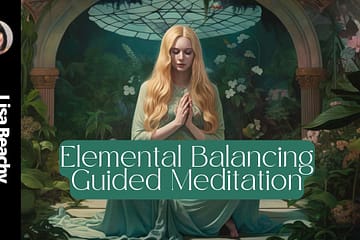What is a Focused Attention Meditation?

I’ll share the techniques that have worked for me over many years of practice. Meditation has been transformational in my life – giving me a sense of calm and joy, even during tough times. It’s also led to beautiful spiritual insights and becoming more receptive to my intuition. I hope by passing on what I’ve learned, you’ll find the same benefits in your own life! Whether you’re brand new to meditation or have some experience, stick with me as we dive in to make this nourishing practice part of your self-love toolkit. There’s no need to be perfect, just bring gentle curiosity and patience with yourself. I believe we all have an inner wisdom we can tap into through spending quiet time focused inward. Let’s embark on the journey together!
What is a focused attention meditation?
A focused attention meditation is a type of meditation where you concentrate your attention on one thing, like your breathing, a mantra, visualization, or part of the body. The goal is to still your mind by giving it one focal point, letting thoughts and distractions pass by without getting caught up in them. This allows you to become more present and find inner calm.
To practice it, choose your object of focus, maybe the feeling of the breath coming in and out of your nostrils. Sit comfortably with a straight back, then bring all your attention to that one thing. When thoughts inevitably crop up, gently notice them, then refocus back to the breath without judgment. Start with short sessions of 5-10 minutes and gradually build up. This type of meditation strengthens concentration, awareness, and mindfulness.
What are the benefits of focused attention meditation?
Some benefits of focused attention meditation include:
- Improves concentration and focus
- Develops mindfulness and awareness of the present moment
- Reduces stress by inducing the relaxation response
- Lowers blood pressure and heart rate
- Helps relieve anxiety and depression
- Improves sleep
- Strengthens parts of the brain tied to learning, memory and emotion regulation
- Can help manage chronic pain
- Fosters self-knowledge and insight
- Creates a sense of calm, inner peace and balance
By training your mind to stay focused, you also gain the ability to redirect your attention when caught up in disturbing thoughts or emotions, letting go of negativity.
How is focused attention meditation different from open monitoring meditation?
Focused attention meditation and open monitoring meditation are two common styles of meditation, and they work in different ways:
- Focused attention involves concentrating on one object like the breath. Open monitoring is more expansive, observing all sensations, thoughts and feelings without getting caught up in any.
- Focused attention relies on effort and concentration to keep bringing the wandering mind back. Open monitoring uses more relaxation and awareness.
- Focused attention meditation can lead to states of calm concentration called jhana or samadhi. Open monitoring can lead to insight about the nature of the mind.
- Focused attention develops concentration. Open monitoring develops equanimity through allowing any experiences without reacting.
- Focused attention aims to still the mind’s chatter. Open monitoring lets the chatter continue while you simply observe.
While different, these styles are complementary. Focused attention can develop the concentration needed for open monitoring. And open monitoring can be used during focused attention practice when the mind wanders. Both are extremely valuable on the path to greater mindfulness.
What are some common objects of focus in focused attention meditation?
Some commonly used points of focus in focused attention meditation include:
- The breath – Paying attention to the sensations of breath entering and leaving the nostrils or chest rising and falling. This is a classic focal point.
- A mantra – Repeating a word, phrase or sound in your mind can keep the attention anchored. Examples are om, loving-kindness phrases or chanting.
- The body – Bringing awareness to physical sensations, either scanning the whole body or focusing on specific points.
- Emotions – Tuning into specific feelings in the body connected with emotions, like tension, warmth, tightness.
- Visualizations – Creating images in the mind’s eye and focusing on visual details can concentrate the mind.
- Nature sounds – Listening fully to sounds like birdsong, water or wind can be a stabilizing anchor for attention.
- Chakras – Resting the attention on energy centers in the body like the heart or crown chakra.
- Candle flames – Gazing steadily at the dancing light of a candle can settle a restless mind.
The object chosen matters less than the consistent returning to it. Anything that has sensory or emotional details to absorb focus works well.
What happens when your mind wanders during focused attention meditation?
It’s completely normal during focused attention meditation for your mind to wander from the object you’re concentrating on. This happens because the mind is so used to jumping from thought to thought. When you notice your attention has drifted:
- Don’t criticize yourself. Wandering and bringing focus back is part of the practice.
- Gently note “thinking” or “wandering” to register you’ve been distracted.
- Release the thoughts and return focus to your point of concentration, like the breath.
- You may have to do this countless times in a session. Repeatedly guiding focus back trains the mind’s “muscle” of attention.
- Use a small amount of effort to redirect your focus, then relax your effort upon refocusing. No need to tense up.
- Consider setting a kind intention towards yourself each time you start again.
With a patient, non-judging attitude, you can turn the mind’s habit of wandering to your advantage, building strength of attention each time you return. This “mental muscle” gradually carries over into daily life.
What are signs of successful focused attention meditation?
Some signs your focused attention meditation practice is going well include:
- Less mind wandering – You’re catching your distractions faster and need to redirect focus less often.
- Sense of absorption – You feel immersed in the object of your concentration.
- Physical relaxation – You notice your body and breath are calmer.
- Lowered intensity of thoughts – Thoughts seem less vivid or enthralling when they do arise.
- Sense of spaciousness – You feel a gap between distractions where focus can stabilize.
- Positive mind states – More patience, equanimity, joy or kindness arise.
- Decreased identification with thoughts – You see them as just “thinking” without taking their content so personally.
Remember progress isn’t linear. Some sits will feel more focused than others. As you continue practicing, try letting go of expectations and rest in being fully present with each moment just as it is.
How can focused attention meditation help with anxiety?
Focusing the attention can be particularly helpful for managing anxiety. Benefits include:
- Calms the body’s fight-or-flight response – Concentrating on the breath slows heart rate, lowers blood pressure, relaxes muscles.
- Occupies the worrying mind – Fixing attention on a neutral object can quiet anxious thoughts and thinking patterns.
- Builds resilience – Each time you return focus to the present after distraction strengthens your ability to self-regulate.
- Cultivates mindfulness – Observing thoughts come and go without reacting reduces their influence over you.
- Releases emotion regulation – Learning to watch anxiety without being swept up in it increases resilience.
- Creates perspective – Focusing on the present helps keep things in perspective rather than catastrophizing.
- Reduces avoidance – Willingly turning towards anxiety with kindly awareness reduces habitual avoidance.
Starting with brief, regular practice can help establish focus as an anchor to return to when anxiety arises, rather than getting caught up in anxious thinking.
How can I make sure I stick with a consistent focused attention meditation practice?
To turn focused attention meditation into an ongoing habit:
- Start small – 5 or 10 minutes each day is enough when starting out. This feels doable versus overwhelming.
- Schedule it – Pick a regular time and make meditation as much a part of your routine as brushing your teeth.
- Use cues – Tie practice to existing habits like right after your morning coffee or before bedtime.
- Make it easy – Have your meditation space set up in advance so you can sit right down when the time comes.
- Use apps and reminders – Calendar alerts and meditation apps can prompt you.
- Join a class – In-person or online groups can motivate you to show up.
- Focus on how good you feel after – Notice the calm and clarity meditation brings versus just thinking of it as another task to cross off.
- Be kind to yourself – If you miss a day, simply begin again the next day. No need for guilt.
By fitting meditation into your lifestyle and making it rewarding, it soon becomes a healthy habit that sticks. Consistency matters more than how long you sit.
What’s the difference between focused attention meditation and concentration?
Though they sound similar, focused attention meditation and concentration are different:
- Concentration is laser-like, demanding exclusive focus on only one object with effort. Meditation is more relaxed, with gently returning focus each time it wanders.
- Concentration blocks out everything else. Meditation remains open, expansive and aware of other sensations even when focusing on one thing.
- Concentration can feel tense and tiring from effort. Meditation has an easeful quality.
- Concentration doesn’t allow distractions. In meditation, distractions are seen as opportunities to calmly return to your object of focus.
- Concentration is limited to the object focused on. Meditation cultivates awareness of the whole field of experience.
- Long concentration can lead to suppression. Meditation creates a peaceful, witnessing quality of mind.
Meditation values a balance between focused but relaxed concentration, and keeping the attention broad enough to remain connected to the present.
Conclusion
In summary, focused attention meditation trains the mind by giving it one point of focus like the breath, then patiently guiding attention back each time it strays. This builds the “muscle” of attention, creates calm, and leads to greater mindfulness and insight. By practicing regularly, you can reduce anxiety, find inner quiet, and gain the ability to direct your awareness skillfully in all areas of life. Experiment to find what techniques work best for you, then set up a daily meditation routine that sticks so you can enjoy the many benefits. Wishing you the very best on your meditation journey!
Summary
| Topic | Summary |
|---|---|
| What is it? | Concentrating attention on one thing like the breath to still the mind |
| Benefits | Improves focus, reduces stress, promotes calm and insight |
| vs. Open Monitoring | Focused on one object vs. expansive awareness of all sensations |
| Objects of Focus | Breath, mantra, visualization, body, emotions, sounds, candle, etc. |
| When Mind Wanders | Gently return focus without self-criticism |
| Signs It’s Working | Less mind-wandering, absorption, relaxation, spaciousness |
| For Anxiety | Calms fight-or-flight, builds coping skills, reduces avoidance |
| Making It a Habit | Start small, schedule it, use cues, apps and groups |
| vs. Concentration | Meditation is relaxed, open; concentration is forced, exclusive |
Frequently Asked Questions
What is the best time of day to do focused attention meditation?
The best time is whatever allows you to meditate consistently. That said, many find first thing in the morning energizing, helping focus all day. Others prefer mid-day as a reset or end of day to unplug before sleep. Experiment to see what feels right for you. Regularity matters most.
How long should I meditate for as a beginner?
Start small – even 5-10 minutes daily can create change. It’s more important to sit regularly than make sessions really long when starting out. You can slowly build as you become accustomed to training your attention this way. But don’t pressure yourself. Short, frequent sits are great.
What do I do if I keep falling asleep during meditation?
Falling asleep often happens when first learning to meditate. Try meditating with eyes open instead of closed. Sit up very straight. Splash cool water on your face beforehand or try energizing breathing. If sleepiness persists, experiment with different times of day to see if you’re more alert. As you strengthen focus, sleepiness will likely diminish.
Is it okay to do guided meditations?
Yes, guided meditations can help build the habit. The guidance can keep you focused, especially when starting out. You may mix guided and silent sessions. Over time, try lengthening your silent periods – even a few minutes in silence is strengthening. Follow what keeps you consistent.
Can I meditate while lying down?
It’s best not to meditate lying down when first learning focused attention, as the mind associates this with sleep. An upright posture is recommended to remain alert. Once you’ve built focus, you can experiment with lying down after if you wish. Sitting up supports stable attention.
What do I do if I’m in pain sitting to meditate?
Sitting meditation with pain can be challenging. Try using props like cushions or blocks to make sitting more comfortable. Change postures if needed – kneeling, standing, or even lying down are options if sitting is too painful. Do exercises beforehand to warm up stiff areas. Start with shorter sessions and know pain may still come and go during practice.
Does my mind ever stop wandering during meditation?
It’s unlikely your mind will ever fully stop wandering, at least during a single session. The mind is conditioned to wander from years of habit. With regular practice, you may notice fewer distractions arise before you catch them. But getting lost in thought and bringing yourself back is part of training attention – it helps strengthen focus over time.
or I have my YouTube Readings Channel : Intuitive Aries, Lisa Beachy
Learn more about Angels – Click Here



